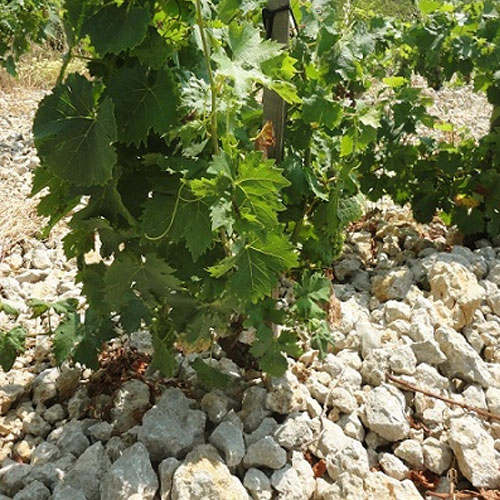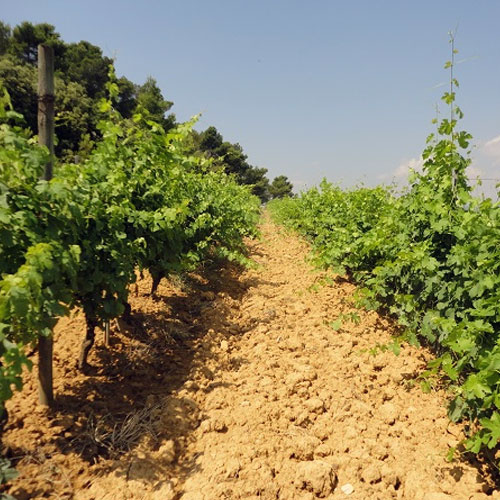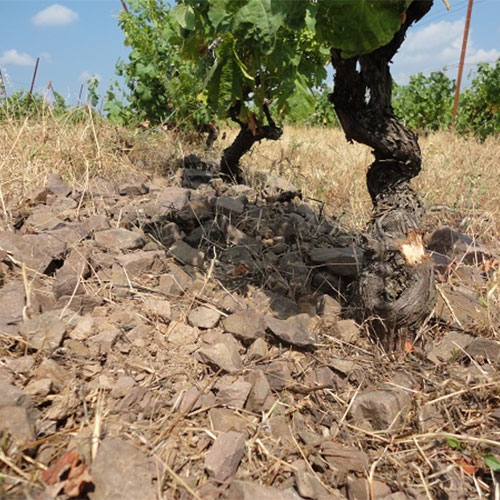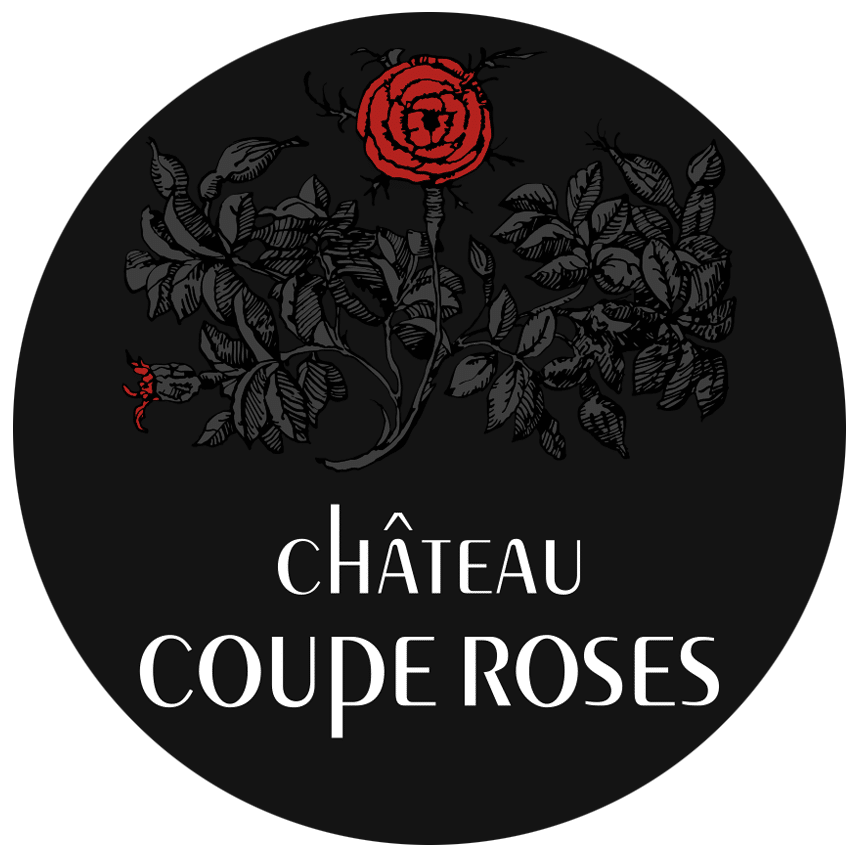Les Terroirs du Château Coupe-Roses
Le Château Coupe-Roses est un enfant du Minervois, pays situé au Nord-Est de Carcassonne et au Sud de la Montagne Noire dont il est le piémont. Son climat constitue une synthèse harmonieuse entre l’ensoleillement méditerranéen et la rudesse montagnarde.
Cette influence de l’altitude se fait davantage sentir dans la région du Causse, où se trouve l‘exploitation, constituée de petites parcelles qui totalisent 22 ha. Elle s’étend sur des coteaux arides et caillouteux, s’échelonnant entre 250 et 400 m d’altitude. Les amplitudes thermiques relativement importantes ont pour conséquence une maturation lente avec une augmentation de l’acidité qui exacerbe les arômes.
Les sols alternent des parties calcaires solides, qui conservent la chaleur, et des couches argileuses plus profondes servant de réserves captant l’eau du ruissellement. Ces parties sont riches en manganèse, d’une coloration qui donne son nom au domaine.
Ces qualités intrinsèques au terroir se doivent d’être mises en valeur par un savoir-faire empreint de respect : chaque parcelle accueille le cépage qui lui est le mieux adapté, amendements, traitements et travail du sol sont réduits au minimum tandis que l’enracinement profond des souches, gage d’un raisin de qualité, est favorisé.
Le terroir est une notion qui ne peut comprendre que l’espace. Bien sûr la géologie, la pédologie, le climat, les expositions, sont une part très importante du concept de terroir, mais tout aussi importante est l’influence du temps. Le vin que nous mettons un cycle à produire n’est finalement que l’influence du temps sur la matière. Ainsi le vin issu d’un lieu doit aussi se définir par l’année qui a vu sa maturation, de la taille jusqu’à la vendange. Le vin n’est ici qu’une condensation d’espace temps, capturée en bouteille, et qui se doit de transmettre tout ce qu’il a accumulé de son terroir et du temps que nous avons passé à le parfaire. En ceci il est la quintessence, le subtil né du grossier.
Nos vins sont le fruit de cette alchimie complexe, de la dialectique permanente entre la nature et la main de l’homme.
Terroirs caillouteux
(300 à 400m d’altitude)

Le principal représentant du terroir dit caillouteux sur nos terres est le tènement du Causse. Planté il y a quelques années sur des espaces alors occupés par la garrigue, mais qui étaient plantés de vignes comme en attestent les repousses de Rupestris du Lot trouvées ça et là.
La recherche historique nous à montré que ces espaces ne sont plus plantés de vignes depuis les années 50. Il n’est pas étonnant que ces parcelles aient été délaissées aussi longtemps, au vu de la difficulté à travailler ces sols pour la plantation. Tout ici n’est que minéral. Mais sous l’épaisse couche de pierre, à première vue inapte à la plantation, se cache une argile noire à l’odeur forte de matière organique. Cette argile fait office de réserve d’eau, avec un taux de matière organique dépassant les 6%. Les faibles pluies d’été s’infiltrent facilement entre les éclats calcaires et viennent gorger ces argiles. Leur évaporation est rendue difficile par la couche pierreuse qui fait office de mulch naturel. L’ensemble offre un terroir remarquablement résistant à la sécheresse.
C’est sur cet îlot que nous avons choisi d’implanter nos vignes de vieux cépages endémiques, sur une surface de 4.8 Ha nous avons ainsi planté du Ribayrenc, de l’Aramon, du Piquepoul, du Cinsault, et les cépages plus mériodionaux que sont les Grenaches Noir et Gris. L’ensemble est séparé en 7 parcelles, toutes complantées d’une multitude d’autres cépages, dont certains sont relativement rares comme le Brun Fourca, le Marocain noir, l’Oeillade par exemple. Une cuvée est réalisée comportant l’ensemble des parcelles de cet îlot, dans des proportions correspondantes à la surface occupée de chaque cépage. Ainsi si chaque parcelle est composée d’une grande variété de cépages (jusqu’à 25), la cuvée est elle même composée de la variété de parcelles issues de ce tènement, pour offrir par syncrétisme la représentation la plus fidèle possible de ce terroir.
Terroirs Argileux
(300 à 400m d’altitude)

La partie Languedocienne de notre famille était pour partie tuiliers entre le XVIIème et le XIXème siècle.
Les fours étaient sur le site actuel de la cave de vinification. La toponymie nous dit que ce site se nommait « fabrique de Coupe-Rose », sans le « s » du pluriel à l’époque. Ce mot désignait l’argile pure gorgée de manganèse qui faisait de jolies tuiles vendues un peu plus chères que les autres… déjà la qualité !
Ainsi la famille Pons, peu à peu, pût racheter maisons, vignes, bergeries, cave… au Baron Treilh de Pardailhan.
Le Château Coupe-Roses est constitué d’un archipel de parcelles. Les argiles y sont variées, chacune doit être appréhendée spécifiquement.
Les tènements de Babio sont les plus argileux de tous. Les trainées rouges violacées, bien accentuées derrière nos rares pluies, attestent l’abondance de l’ion Manganèse, apanage des très grands crus de Bourgogne blanc. La ressemblance s’arrête là !
Les surfaces internes de ces argiles sont moyennement faibles. Les vins blancs s’y trouvent très à l’aise pour nous offrir des expressions aromatiques et structurelles très ciselées dans la vivacité.
Sur ce tènement, trois parcelles sont implantées. Le grenache blanc sera marié dans le Champ du Roy. Le viognier nous livre, avec une parcimonie extrême, une petite cuvée de cépage strictement pur, sobre et délicieuse, commercialisée sous la dénomination Vin de France.
Une troisième parcelle est encépagée en Roussanne avec un peu de Marsanne. Elle nous livre parfois des vendanges tardives vinifiées pour faire de vieux Rancios selon notre tradition paysanne. Mais généralement nous l’associons à la Roussanne des schistes d’altitude dans la cuvée Schiste.
D’autres argiles, moins pures, s’accumulent en colluvions derrière les massifs murs de pierre, comme sur le Chemin des Crozes (1). Les rouges Carignans y trouvent un équilibre de vin sympa, prenant de l’amplitude dans son association avec le Grenache noir.
Nous avons aussi des argiles qui migrent à chaque pluie des tènements abandonnés des côtes sud de Babio pour recouvrir d’énormes cailloux. Sur ces espaces chaotiques, nous avons implanté des oliveraies. Un peu plus bas, dans le lit de la Cesse (2), les argiles se lient avec les sables et graviers des inondations.
Partout, l’argile est un casse-tête agronomique. Le réveil de la vie microbienne et la connaissance meilleure des vertus des matières organiques spécifiquement préparées constituent une promesse de nouvelles prouesses œnologiques.
(1) : Nom désignant en occitan des anfractuosités dans les rochers et falaises (cf Crozes-Hermitage).
(2) : Rivière large à régime Méditerranéen.
Terroirs de Schistes
(400m d’altitude)

Les vignobles plantés sur schistes donnent toujours des vins très singuliers et remarquables. Certains d’entre eux bénéficient d’une reconnaissance internationale très ancienne (Collioure, Banyuls, Faugères, etc). Il est probable que de grands vignobles de schistes dorment sous des friches à qui l’histoire humaine n’a pas donné l’occasion de s’épanouir.
Les schistes qui composent notre parcelle de Roussanne sont d’origine pré-cambrienne (la première et la plus longue période sur l’échelle des temps géologiques). Le sol de cette parcelle est donc directement issu de la dégradation de sols qui comptent parmi les plus vieux au monde.
Ces sols sont extrêmement pauvres, l’implantation du système racinaire est très lente du fait de l’organisation horizontale de notre schiste. Dans la parcelle prise en photo, la proportion de terre fine est très faible, ce qui ne permet pas une bonne rétention en eau. L’expression végétative traduit cette situation hydrique extrême. Stress hydrique qui est mal supporté par la Roussanne. L’apport régulier en matière organique permet d’assurer une vie microbienne riche, favorisant le très lent mécanisme d’enracinement. Tous ces points entraînent un très faible rendement (15hL/Ha), met en valeur des expressions originales, marqué par des touches végétales (en particulier la bruyère) et empyreumatique (tabac à rouler par exemple).
